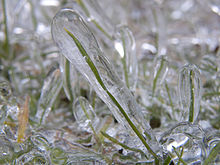Clear ice
Under clear ice , and ice (in the strict sense) English glaze , glaze ice, glaze frost , is understood in the meteorology that weather-related deposit of ice that have become completely transparent, vitreous ice on freezing rain , drizzle , and the like precipitate forms.
Causes and origins
Clear ice typically forms with supercooled rain (rain that forms from supercooled fog water droplets ) when it spontaneously crystallizes and accumulates as cloud-free ice when it hits surfaces , less often with freezing rain (normal rain that hits on frozen ground), freezing humidity and the like : This usually results in a rather diffuse structure with air inclusions or strong crystallization boundaries, which are referred to instead as rough ice or rough rust . Both phenomena are to be distinguished from frozen dew , frost and hoar frost .
Since the energy bound as heat of crystallization is released again during ice formation , the surface melts and the following drops can continue to freeze without visible crystal surfaces and gradually thicken the layer. This is what defines the characteristic appearance of Klareis.
In everyday weather events with the various types of precipitation and especially when fluctuating around the zero degree limit, all these forms can mix and overlap, exclusive clear ice events are comparatively rare.
Natural phenomena

Especially when this precipitation is on asphalt and other dark underground, one also speaks of black ice, an expression that comes primarily from shipping and describes the ice layer of bodies of water (where this ice, being particularly compact and sharp-edged, represents a particular danger) and has been reinterpreted has been. Clear ice, like rime, accumulates on all surfaces, including plants, structures and technical systems such as branches and overhead lines , where it can lead to damage due to the sometimes considerable additional weight load ( ice breakage ). Due to its higher density and strength as well as the consistently rapid ice formation, such a risk is particularly pronounced with clear ice.
In addition to explicit precipitation, clear ice forms - with sufficiently cold air and in prolonged periods of strong cold - particularly heavily on plants that grow on or above open water, solely through the humidity through evaporation. Where water splashes or spray from water spray reach the branches, the ice tends to be cloudy, as does the sea coasts and lake shores ( spray ice). Overhanging branches can freeze to such an extent that the weight of the ice pulls them even closer to or partially into the water, so that the part of the ice covering that is washed around melts again, but huge ice floes form just above the surface of the water.
The fact that energy is released when over-freezing is also used in frost protection irrigation in agriculture (anthropogenic precipitation): The covered part of the plant is also warmed, which can prevent frost damage to the flower, for example. This also creates typical clear ice.
Clear ice and aviation
Clear ice that accumulates on the wings and control surfaces of aircraft before and during the flight and “ices up” them is dangerous for safe flight operations, as the rudders can be blocked by the ice. Lightning-like clear ice formation on the cockpit windows can also completely obstruct the outside view, so that the pilot cannot land safely. The flying weight of an aircraft can increase so much through clear ice that it can no longer increase even with full engine power. Clear ice, the airfoil change so disadvantageous that a stall even at much higher airspeeds threatening than usual. Depending on the severity of the clear icing, a distinction is made between “ light clear ice ”, “moderate icing” ( moderate clear ice ) and “ severe clear ice ”. The same applies, of course, to rough icing, the formation of clear ice is the bigger problem in aviation because the aircraft itself is the mechanical trigger for crystallization when flying through supercooled rain, and the formation of clear ice is particularly intense due to the high flight speed.
There are special symbols for the occurrence of icing in special aviation weather maps ( Significant Weather Chart, SWC ).
Measures against the formation of ice before and during the flight are known as aircraft de-icing .
Individual evidence
- ↑ Joachim Blüthgen, Wolfgang Weischet: General climate geography. Volume 2 by Wolfgang Weischet (Ed.): Textbook of general geography . Walter de Gruyter, 1980, ISBN 978-311006561-9 , section deposits , p. 281 ff ( limited preview in the Google book search).
- ^ Secretariat of the World Meteorological Organization (ed.): International Cloud Atlas . Geneva 1975, ISBN 92-63-10407-7 .
- ↑ Rachelle Oblack: Glaze Ice definition . Archived from the original on August 22, 2008. Info: The archive link was inserted automatically and has not yet been checked. Please check the original and archive link according to the instructions and then remove this notice. Retrieved July 18, 2009.
- ↑ ex. Brochure aviation weather information in Switzerland by Meteoschweiz, November 2013, page 14 ( Memento of the original from December 14, 2014 in the Internet Archive ) Info: The archive link has been inserted automatically and has not yet been checked. Please check the original and archive link according to the instructions and then remove this notice.

